On the Effect of a Rail Pressure Error State Observer in Reducing Fuel Injection Cycle-to-Cycle Variation in an Opposed-Piston Compression Ignition Engine
Abstract
:1. Introduction
2. Mathematical Model of CRS and OBS
2.1. Control Principle of CRS
2.2. Control-Oriented Mathematical Model of CRS
2.3. Mathematical Model of OBS
3. Experimental Specifications
4. Results and Discussion
4.1. Rail Pressure in a Pumping–Injection Cycle
4.2. Cycle-to-Cycle Variation in Injection Pressure and Quantity
4.3. Rail Pressure in a Pumping–Injection Cycle
4.4. Effect of Pressure Oscillation on Spray Combustion
5. Concluding Remarks
Author Contributions
Funding
Acknowledgments
Conflicts of Interest
References
- Herfatmanesh, M.R.; Peng, Z.; Ihracska, A.; Lin, Y.; Lu, L.; Zhang, C. Characteristics of Pressure Wave in Common Rail Fuel Injection System of High-Speed Direct Injection Diesel Engines. Adv. Mech. Eng. 2016, 8, 1–8. [Google Scholar] [CrossRef]
- Du, W.; Lou, J.; Yan, Y.; Bao, W.; Liu, F. Effects of Injection Pressure on Diesel Sprays in Constant Injection Mass Condition. Appl. Therm. Eng. 2017, 121, 234–241. [Google Scholar] [CrossRef]
- Pielecha, I. The Influence of Petrol Injection Parameters on the Structure of Geometry of Fuel Spray Injected from Outward-Opening Injectors. Fuel 2018, 222, 64–73. [Google Scholar] [CrossRef]
- Ferrari, A.; Paolicelli, F. An Indirect Method for the Real-Time Evaluation of the Fuel Mass Injected in Small Injections in Common Rail Diesel Engines. Fuel 2016, 191, 322–329. [Google Scholar] [CrossRef]
- Ren, W.J.; Shi, X.X.; Jiao, S.J.; Zhu, C.J.; Zhang, Q. Research on Rail Pressure Control of Diesel Engine Based on Genetic Algorithm Nonlinear PID. In Proceedings of the IEEE International Conference on Computer Science and Automation Engineering, Shanghai, China, 10–12 June 2011; pp. 67–71. [Google Scholar]
- Ji, Z.; Xie, X.; Sun, Z.; Chen, P. Rail Pressure Control of Common Rail Diesel Engine Based on RBF Neural Network Adaptive PID Controller. In Proceedings of the IEEE International Conference on Electronic and Mechanical Engineering and Information Technology, Harbin, China, 12–14 August 2011; pp. 1122–1125. [Google Scholar]
- Song, G.M.; Yang, F.Y.; Ouyang, M.G.; Hu, L.F.; Hang, Y. Equilibrium Algorithm Research for Each Individual Cylinders of Common Rail Based on Self-Adaptive Fuzzy Control. Trans. Csice 2005, 23, 451–456. [Google Scholar] [CrossRef]
- Montanaro, U.; Gaeta, A.D.; Giglio, V. An MRAC Approach for Tracking and Ripple Attenuation of the Common Rail Pressure for GDI Engines. In Proceedings of the 18th IFAC World Congress (IFAC 2011), Milan, Italy, 28 August–2 September 2011; pp. 4173–4180. [Google Scholar]
- Hong, S.; Shin, J.; Sohn, J.; Park, I.; Sunwoo, M. Coordinated Control Strategy for the Common-Rail Pressure Using a Metering Unit and a Pressure Control Valve in Diesel Engines. Proc. Inst. Mech. Eng. Part D J. Automob. Eng. 2015, 229, 898–911. [Google Scholar] [CrossRef]
- Payri, F.; Luján, J.M.; Guardiola, C.; Rizzoni, G. Injection Diagnosis through Common-Rail Pressure Measurement. Proc. Inst. Mech. Eng. Part D J. Automob. Eng. 2006, 220, 347–357. [Google Scholar] [CrossRef]
- Akiyama, H.; Yuasa, H.; Kato, A.; Saiki, T.; Sanada, K.; Kado, N. Precise Fuel Control of Diesel Common-Rail System by Using OFEM; SAE Technical Paper, 2010-01-0876; SAE International: Warrendale, PA, USA, 2010. [Google Scholar]
- Wu, Z.; Chen, Y. Experimental Study on Rail Pressure Signal Processing of High Pressure Common Rail Fuel System. Automob. Appl. Tech. 2016, 5, 78–80. [Google Scholar] [CrossRef]
- Tao, Q.; Wang, C.; Fang, Z.; Qi, Z.; Yin, W. Research on Rail Pressure Signal Processing Method of High Pressure Common Rail System. In Proceedings of the IEEE International Conference on Optoelectronics and Image Processing, Haikou, China, 11–12 November 2010; pp. 274–276. [Google Scholar]
- Catania, A.E.; Ferrari, A.; Manno, M.; Spessa, E. Experimental Investigation of Dynamics Effects on Multiple-Injection Common Rail System Performance. J. Eng. Gas Turbines Power 2008, 130, 460–466. [Google Scholar] [CrossRef] [Green Version]
- Henein, N.A.; LaiM, C.; Singh, I.P.; Zhong, L.; Han, J. Characteristics of a Common Rail Diesel Injection System under Pilot and Post Injection Modes; SAE Technical Paper, 2002-01-0218; SAE International: Warrendale, PA, USA, 2002. [Google Scholar]
- Bianchi, G.M.; Falfari, S.; Pelloni, P.; Filicori, F.; Milani, M. A Numerical and Experimental Study towards Possible Improvements of Common Rail Injectors; SAE Technical Paper, 2002-01-0500; SAE International: Warrendale, PA, USA, 2002. [Google Scholar]
- Catania, A.E.; Ferrari, A.; Manno, M. Parametric Study of Hydraulic Layout Effects on Common-Rail Multiple Injections. In Proceedings of the ASME ICED Fall Technical Conference, Ottawa, ON, Canada, 11–14 September 2005; pp. 1–12. [Google Scholar]
- Catania, A.E.; Ferrari, A.; Manno, M. Development and Application of a Complete Multijet Common-Rail Injection-System Mathematical Model for Hydrodynamic Analysis and Diagnostics. J. Eng. Gas Turbines Power 2008, 130, 181–192. [Google Scholar] [CrossRef]
- Lino, P.; Maione, B.; Rizzo, A. Nonlinear Modelling and Control of a Common Rail Injection System for Diesel Engines. Appl. Math. Model. 2007, 31, 1770–1784. [Google Scholar] [CrossRef]
- Baur, R.; Blath, J.P.; Bohn, C.; Kallage, F.; Schultalbers, M. Modeling and Identification of a Gasoline Common Rail Injection System; SAE Technical Paper, 2014-01-0196; SAE International: Warrendale, PA, USA, 2014. [Google Scholar]
- Alessandro, G.; Giovanni, F.; Angelo, P.; Veniero, G.D. Design and Experimental Validation of a Model-Based Injection Pressure Controller in a Common Rail System for GDI Engine. In Proceedings of the American Control Conference, San Francisco, CA, USA, 29 June–1 July 2011; pp. 5273–5278. [Google Scholar]
- Oppenheim, I. Statistical Thermodynamics: Fundamentals and Applications. J. Stat. Phys. 2006, 125, 245–276. [Google Scholar] [CrossRef]
- Hilborn, R.C. Introduction to Modern Dynamics: Chaos, Networks, Space, and Time. Am. J. Phys. 2015, 83, 741. [Google Scholar] [CrossRef]
- Herfatmanesh, M.R.; Lu, P.; Attar, M.A.; Zhao, H. Experimental Investigation into the Effects of Two-Stage Injection on Fuel Injection Quantity, Combustion and Emissions in a High-Speed Optical Common Rail Diesel Engine. Fuel 2013, 109, 137–147. [Google Scholar] [CrossRef]
- Kyrtatos, P.; Brückner, C.; Boulouchos, K. Cycle-to-Cycle Variations in Diesel Engines. Appl. Energy 2016, 171, 120–132. [Google Scholar] [CrossRef]
- Venugopal, R.; Abani, N.; MacKenzie, R. Effects of Injection Pattern Design on Piston Thermal Management in an Opposed-Piston Two-Stroke Engine; SAE Technical Paper, 2013-0148-7191; SAE International: Warrendale, PA, USA, 2013. [Google Scholar]
- Franke, M.; Huang, H.; Liu, J.; Geistert, A.; Adomeit, P. Opposed Piston Opposed Cylinder (OPOC™) 450 hp Engine: Performance Development by CAE Simulations and Testing; SAE Technical Paper, 2006-01-0277; SAE International: Warrendale, PA, USA, 2006. [Google Scholar]
- Zhang, Z.; Zhang, P.; Zhao, Z. Spray Impingement and Combustion in a Model Opposed-Piston Compression Ignition Engine. Combust. Sci. Technol. 2017, 189, 1943–1965. [Google Scholar] [CrossRef]
- Hountalas, D.T.; Kouremenos, A.D. Development of a Fast and Simple Simulation Model for the Fuel Injection System of Diesel Engines. Adv. Eng. Softw. 1998, 29, 13–28. [Google Scholar] [CrossRef]
- Law, C.K. Combustion Physics; Cambridge University Press: Cambridge, UK, 2010. [Google Scholar]
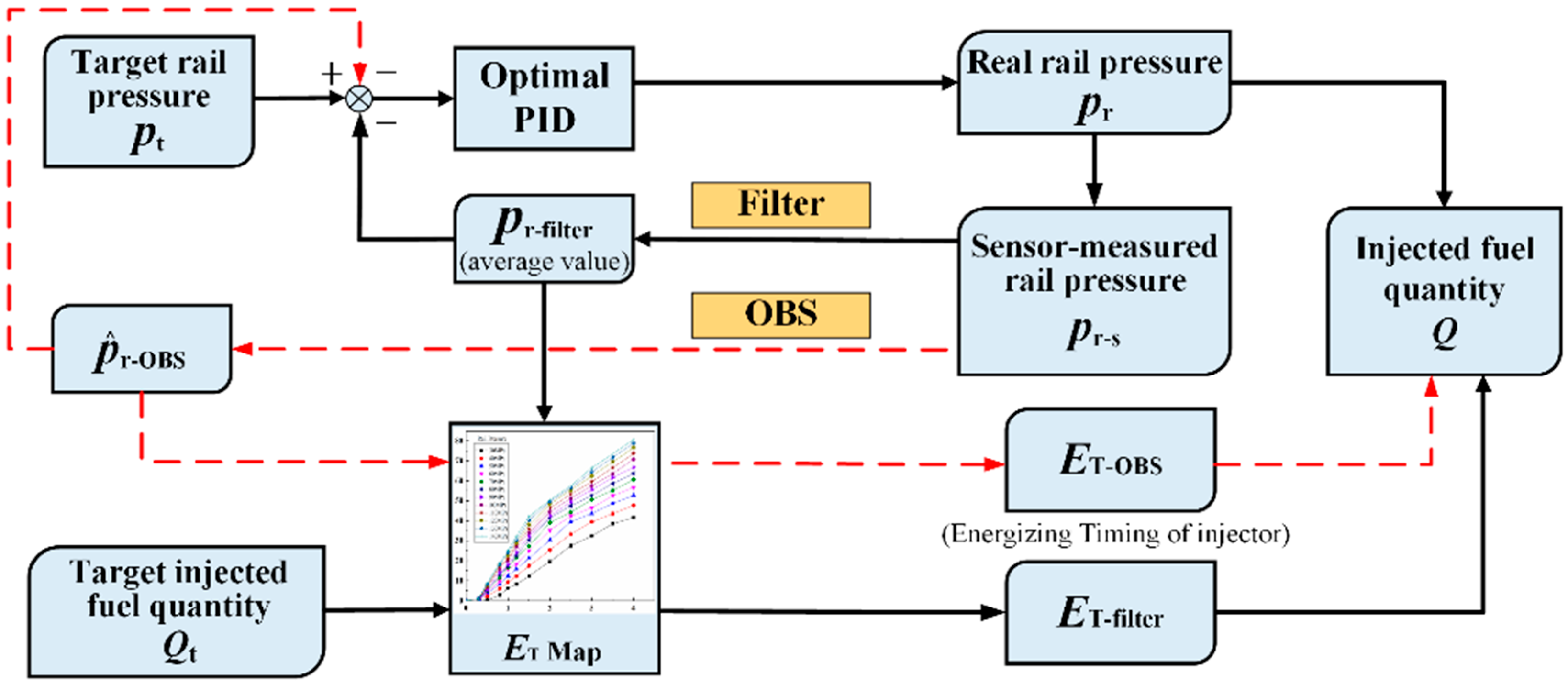
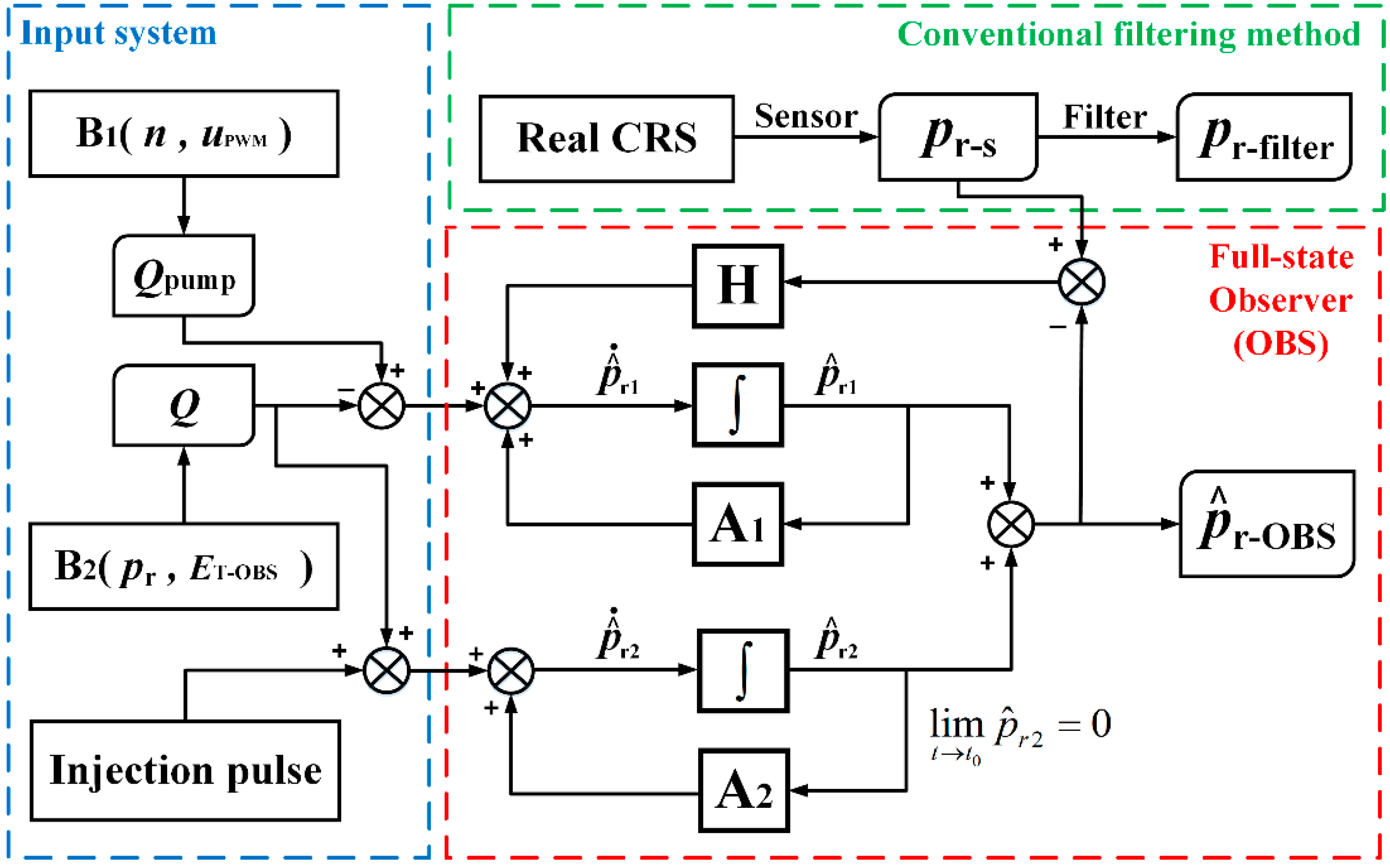



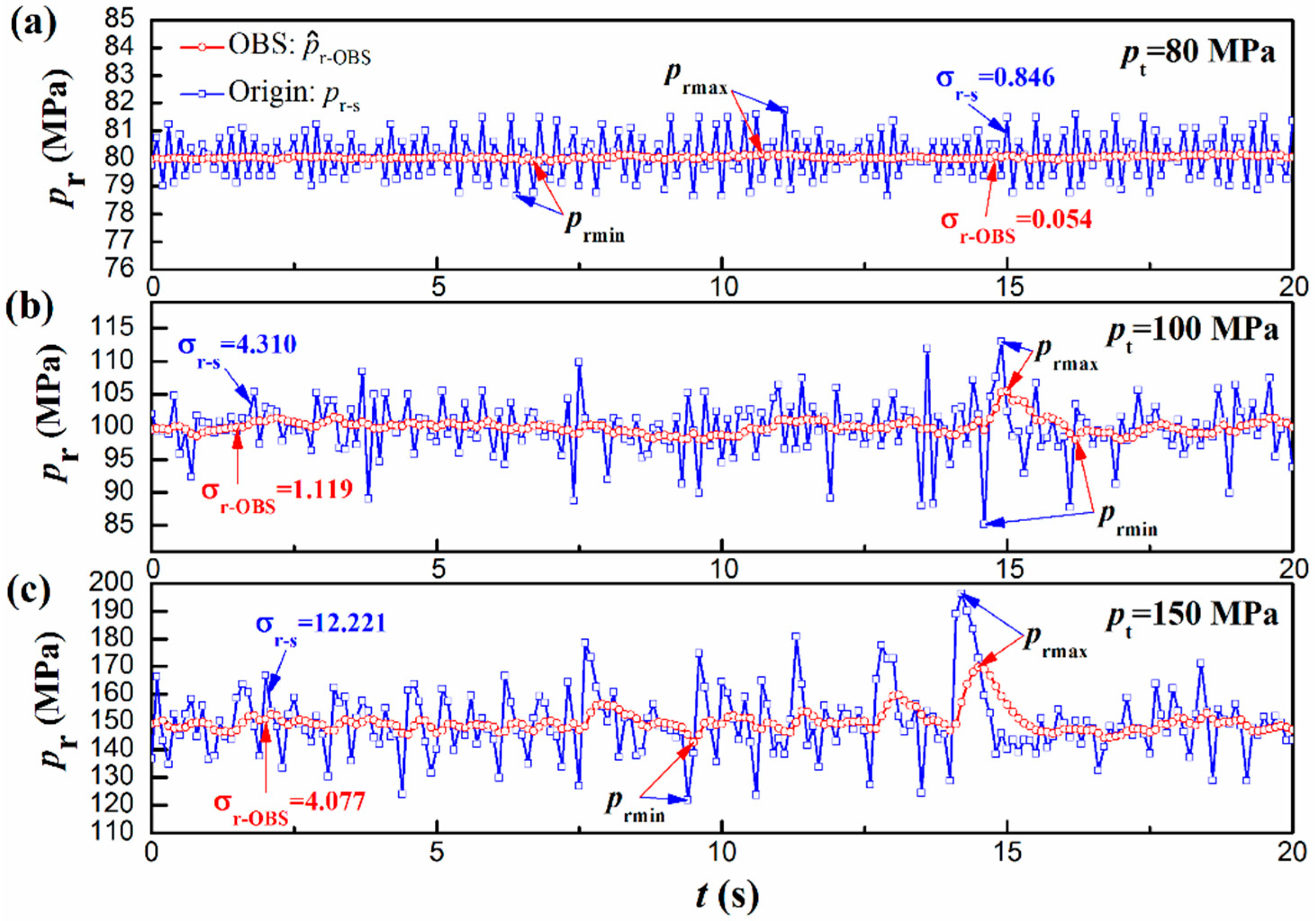
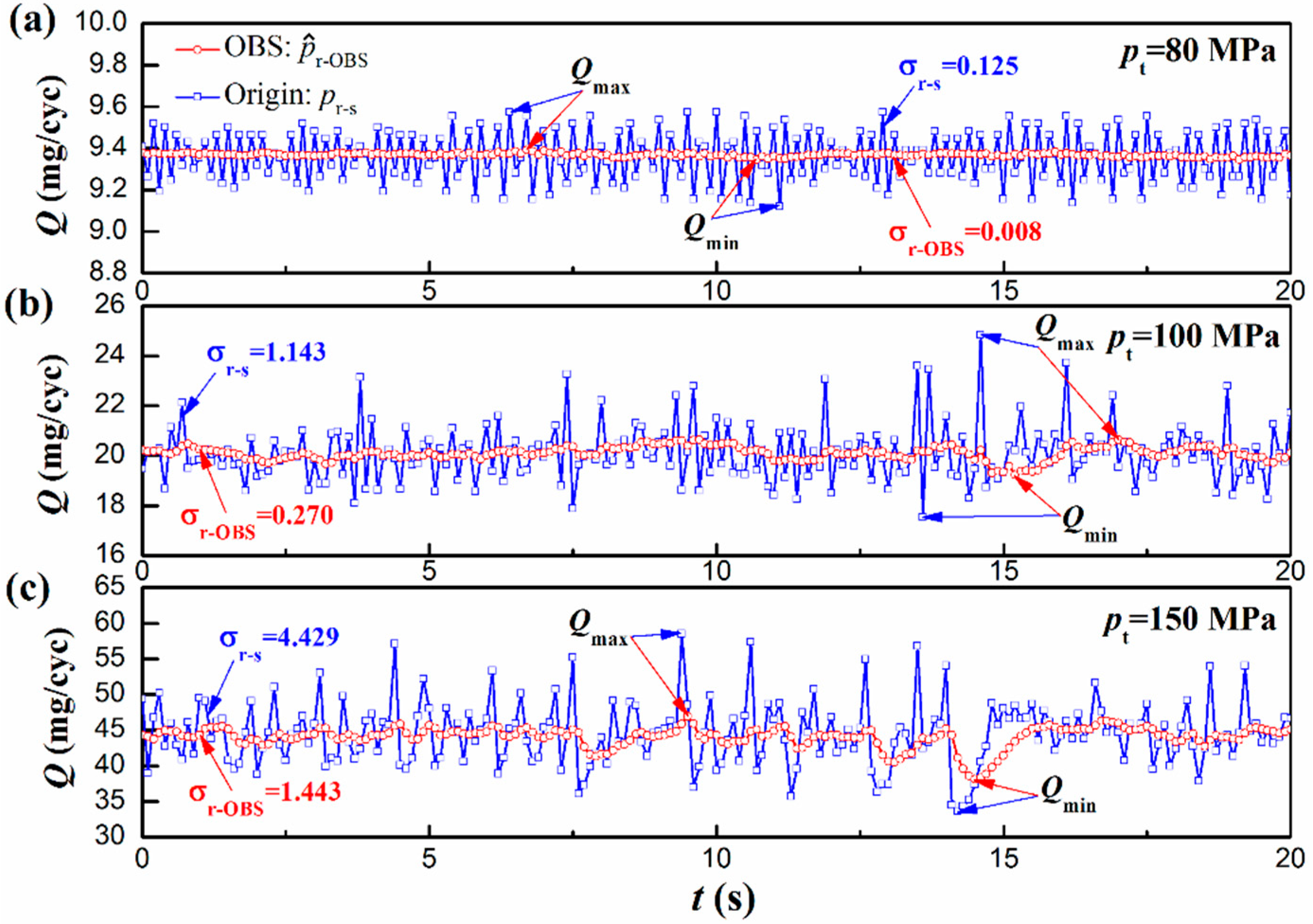
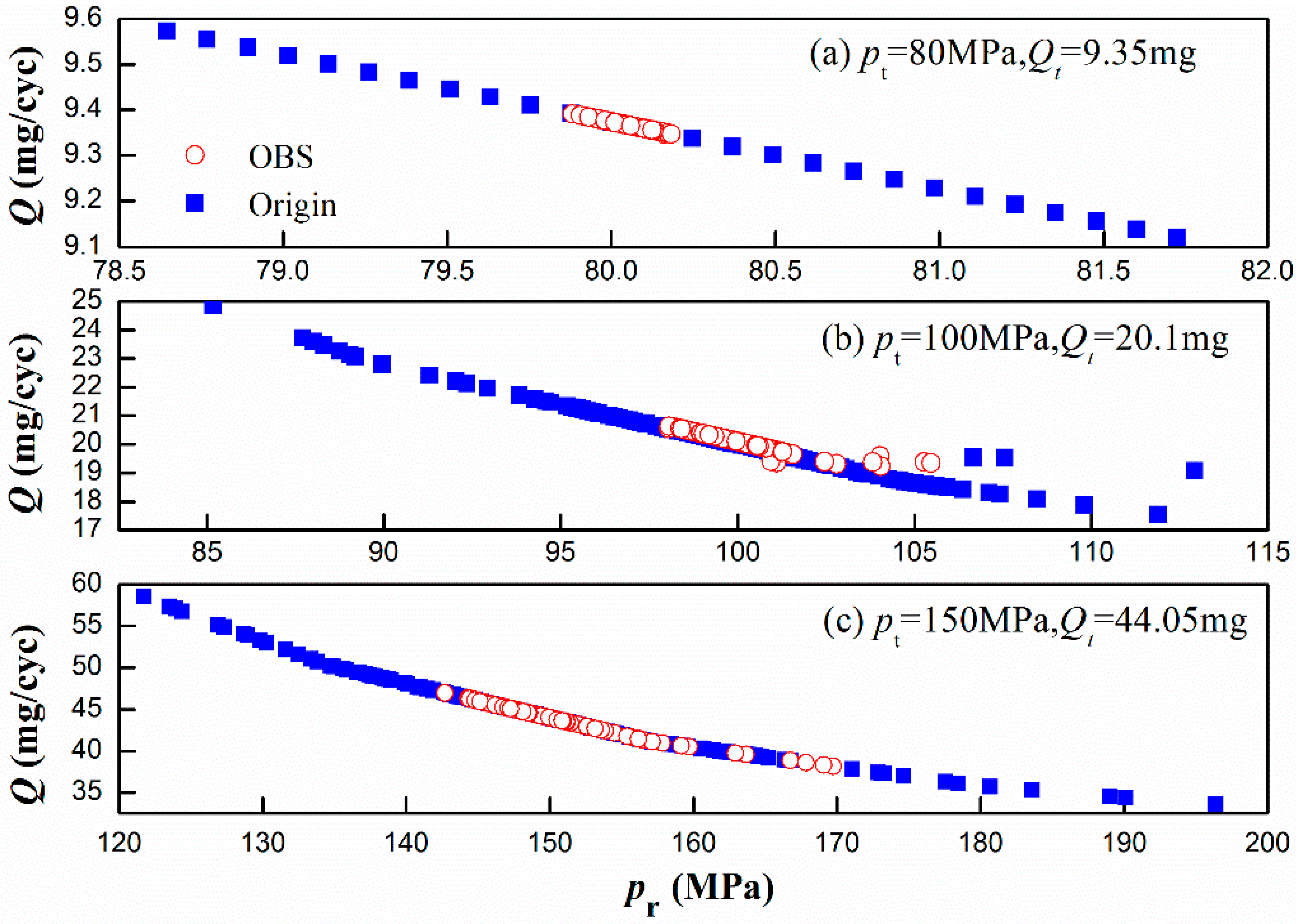
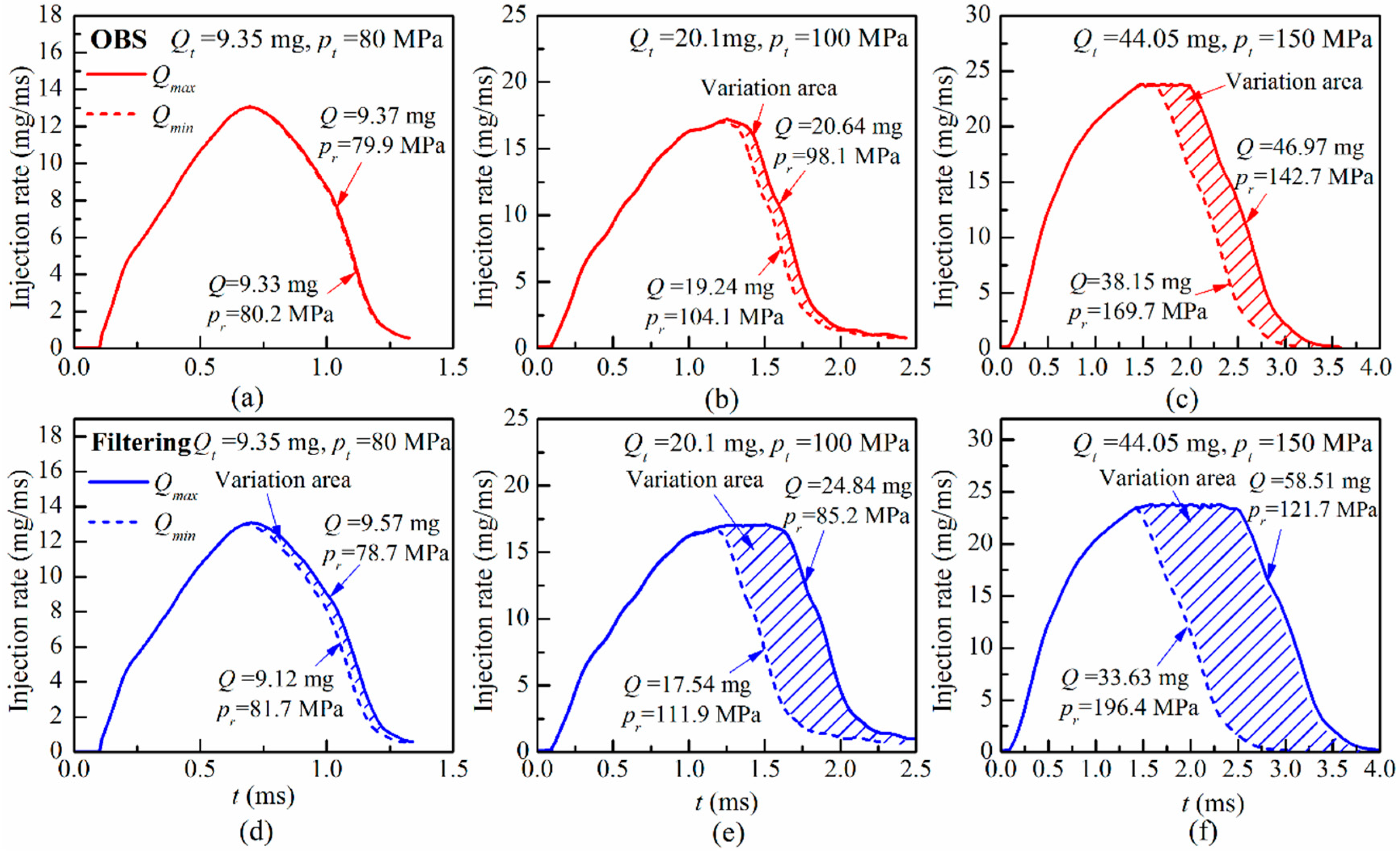


© 2018 by the authors. Licensee MDPI, Basel, Switzerland. This article is an open access article distributed under the terms and conditions of the Creative Commons Attribution (CC BY) license (http://creativecommons.org/licenses/by/4.0/).
Share and Cite
Lu, Y.; Zuo, Z.; Zhang, Z.; Zhao, C.; Zhang, F. On the Effect of a Rail Pressure Error State Observer in Reducing Fuel Injection Cycle-to-Cycle Variation in an Opposed-Piston Compression Ignition Engine. Energies 2018, 11, 1729. https://doi.org/10.3390/en11071729
Lu Y, Zuo Z, Zhang Z, Zhao C, Zhang F. On the Effect of a Rail Pressure Error State Observer in Reducing Fuel Injection Cycle-to-Cycle Variation in an Opposed-Piston Compression Ignition Engine. Energies. 2018; 11(7):1729. https://doi.org/10.3390/en11071729
Chicago/Turabian StyleLu, Yi, Zhe Zuo, Zhenyu Zhang, Changlu Zhao, and Fujun Zhang. 2018. "On the Effect of a Rail Pressure Error State Observer in Reducing Fuel Injection Cycle-to-Cycle Variation in an Opposed-Piston Compression Ignition Engine" Energies 11, no. 7: 1729. https://doi.org/10.3390/en11071729




